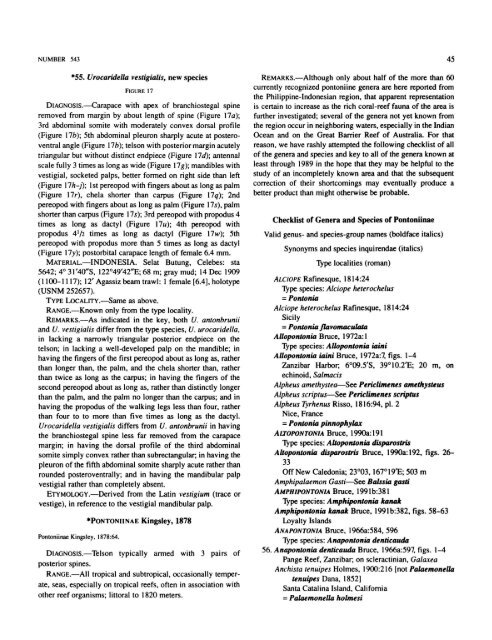Part 2 - AToL Decapoda
Part 2 - AToL Decapoda
Part 2 - AToL Decapoda
You also want an ePaper? Increase the reach of your titles
YUMPU automatically turns print PDFs into web optimized ePapers that Google loves.
NUMBER 543 45<br />
*55. Urocaridella vestigialis, new species<br />
FIGURE 17<br />
DIAGNOSIS.—Carapace with apex of branchiostegal spine<br />
removed from margin by about length of spine (Figure 17a);<br />
3rd abdominal somite with moderately convex dorsal profile<br />
(Figure \7b); 5th abdominal pleuron sharply acute at posteroventral<br />
angle (Figure 17 b); telson with posterior margin acutely<br />
triangular but without distinct endpiece (Figure \7d); antennal<br />
scale fully 3 times as long as wide (Figure 17g); mandibles with<br />
vestigial, socketed palps, better formed on right side than left<br />
(Figure \7h-j); 1st pereopod with fingers about as long as palm<br />
(Figure 17r), chela shorter than carpus (Figure \7q); 2nd<br />
pereopod with fingers about as long as palm (Figure 175), palm<br />
shorter than carpus (Figure 17s); 3rd pereopod with propodus 4<br />
times as long as dactyl (Figure 17M); 4th pereopod with<br />
propodus 4*/2 times as long as dactyl (Figure 17w); 5th<br />
pereopod with propodus more than 5 times as long as dactyl<br />
(Figure 17y); postorbital carapace length of female 6.4 mm.<br />
MATERIAL.—INDONESIA. Selat Butung, Celebes: sta<br />
5642; 4° 31'40"S, 122°49'42"E; 68 m; gray mud; 14 Dec 1909<br />
(1100-1117); 12' Agassiz beam trawl: 1 female [6.4], holotype<br />
(USNM 252657).<br />
TYPE LOCALITY.—Same as above.<br />
RANGE.—Known only from the type locality.<br />
REMARKS.—As indicated in the key, both U. antonbrunii<br />
and U. vestigialis differ from the type species, U. urocaridella,<br />
in lacking a narrowly triangular posterior endpiece on the<br />
telson; in lacking a well-developed palp on the mandible; in<br />
having the fingers of the first pereopod about as long as, rather<br />
than longer than, the palm, and the chela shorter than, rather<br />
than twice as long as the carpus; in having the fingers of the<br />
second pereopod about as long as, rather than distinctly longer<br />
than the palm, and the palm no longer than the carpus; and in<br />
having the propodus of the walking legs less than four, rather<br />
than four to to more than five times as long as the dactyl.<br />
Urocaridella vestigialis differs from U. antonbrunii in having<br />
the branchiostegal spine less far removed from the carapace<br />
margin; in having the dorsal profile of the third abdominal<br />
somite simply convex rather than subrectangular; in having the<br />
pleuron of the fifth abdominal somite sharply acute rather than<br />
rounded posteroventrally; and in having the mandibular palp<br />
vestigial rather than completely absent.<br />
ETYMOLOGY.—Derived from the Latin vestigium (trace or<br />
vestige), in reference to the vestigial mandibular palp.<br />
Pontoniinae Kingsley, 1878:64.<br />
•PONTONIINAE Kingsley, 1878<br />
DIAGNOSIS.—Telson typically armed with 3 pairs of<br />
posterior spines.<br />
RANGE.—All tropical and subtropical, occasionally temperate,<br />
seas, especially on tropical reefs, often in association with<br />
other reef organisms; littoral to 1820 meters.<br />
REMARKS.—Although only about half of the more than 60<br />
currently recognized pontoniine genera are here reported from<br />
the Philippine-Indonesian region, that apparent representation<br />
is certain to increase as the rich coral-reef fauna of the area is<br />
further investigated; several of the genera not yet known from<br />
the region occur in neighboring waters, especially in the Indian<br />
Ocean and on the Great Barrier Reef of Australia. For that<br />
reason, we have rashly attempted the following checklist of all<br />
of the genera and species and key to all of the genera known at<br />
least through 1989 in the hope that they may be helpful to the<br />
study of an incompletely known area and that the subsequent<br />
correction of their shortcomings may eventually produce a<br />
better product than might otherwise be probable.<br />
Checklist of Genera and Species of Pontoniinae<br />
Valid genus- and species-group names (boldface italics)<br />
Synonyms and species inquirendae (italics)<br />
Type localities (roman)<br />
ALCIOPE Rafinesque, 1814:24<br />
Type species: Alciope heterochelus<br />
= Pontonia<br />
Alciope heterochelus Rafinesque, 1814:24<br />
Sicily<br />
= Pontonia flavomaculata<br />
Allopontonia Bruce, 1972a:l<br />
Type species: Allopontonia iaini<br />
Allopontonia iaini Bruce, 1972a:7, figs. 1-4<br />
Zanzibar Harbor; 6°09.5'S, 39°10.2'E; 20 m, on<br />
echinoid, Salmacis<br />
Alpheus amethystea—See Periclimenes amethysteus<br />
Alpheus scriptus—See Periclimenes scriptus<br />
Alpheus Tyrhenus Risso, 1816:94, pi. 2<br />
Nice, France<br />
= Pontonia pinnophylax<br />
AUOPONTOMA Bruce, 1990a: 191<br />
Type species: AUopontonia disparostris<br />
AUopontonia disparostris Bruce, 1990a: 192, figs. 26-<br />
33<br />
Off New Caledonia; 23°03,167°19'E; 503 m<br />
Amphipalaemon Gasti—See Balssia gasti<br />
AMPHIPONTONIA Bruce, 1991b:381<br />
Type species: Amphipontonia kanak<br />
Amphipontonia kanak Bruce, 1991b:382, figs. 58-63<br />
Loyalty Islands<br />
ANAPONTONIA Bruce, 1966a:584, 596<br />
Type species: Anapontonia denticauda<br />
56. Anapontonia denticauda Bruce, 1966a:597, figs. 1-4<br />
Pange Reef, Zanzibar; on scleractinian, Galaxea<br />
Anchista tenuipes Holmes, 1900:216 [not PalaemoneUa<br />
tenuipes Dana, 1852]<br />
Santa Catalina Island, California<br />
= PalaemoneUa holmesi

















